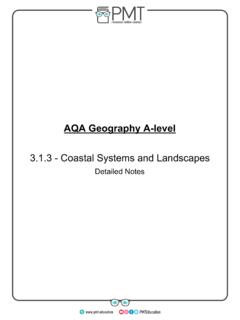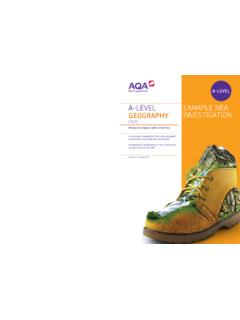Transcription of GCSE Geography Paper 2 - Ullswater Community College
1 gcse GeographyPaper 2 Section A:Urban issues and challenges (Rio and Bristol)Urban planning to improve quality of life for the urban poor (Favela Bairro)Urban regeneration project in the UK (Temple Quarter, Bristol)Urban sustainability and Urban transport StrategiesSection B:Development, causes and consequences of uneven to reduce development gap & Tourism in JamaicaEconomical development in NigeriaEconomic change in the UKSection C:Resource ManagementEnergyExample of gas extractionOne Last Issues and ChallengesThe global pattern of urban change and urban trends in different parts of the world urbanisation is slower in HICs than LICs because most area than can be urbanised are urbanised and the birth rate is slower than LICs. LICs urbanise due to improved economic development, industry and trade that HICs have already had/got. In the majority of HICs over 60% of the country s population live in urban areas. Urbanisation is increasing in places such as India, China and of urbanisation migration (push and pull factors) and natural cities with over 10 000000 people living in them, often found towards the coast.
2 Tokyo, Lagos and New Issues and Challenges (Rio de Janeiro) LIC/ NEE Location and importance Brazil s Atlantic coast at 23 S and 43 W. It has grown around a large natural bay called Guanabara Bay. Until 1960, Rio was the capital of Brazil, the capital is now Brasilia. Rio is an NEE. Brazil s GPD is trillion. Regional (local) importance hospitals, schools and employment. National (Brazil) importance second largest city in Brazil, construction companies, 5% to Brazil s GDP. In 2013, Rio accounted for 12% of Brazil s (global) importance tourism -statue of Christ (one of the seven new wonders of the world), world cup 2014, Olympics 2016. Trade of food, clothing and Issues and Challenges (Rio de Janeiro) LIC/ NEE Causes of urban growth migration (from China to set up trade, from surrounding countries and the Amazon Basin for jobs, education and healthcare) and natural increase ( births per woman). The north zone is poor, west zone is urban growth has created opportunities social: access to services health(Santa Maria medics visited homes to detect and treat diseases) and education (99% literacy rate).
3 Access to resources water supply (95% of the population had mains water supply by 2014), energy (60km of new power lines installed).economic: how urban industrial areas can be a stimulus for economic development/trade/jobs (Rio is second most important city in Brazil, Rio provides 6% of Brazil s employment, it has one of the highest incomes per person in Brazil, types of employment include oil, retail, steel, tourism and construction). bUrban Issues and Challenges (Rio de Janeiro) LIC/ NEE How urban growth has created challenges: managing urban growth slums, squatter settlements providing clean water and sanitation systems (Guanabara bay is very polluted, 200 tonnes of raw sewage and 50 tonnes of industrial waste pumped into the Bay daily) and energy (frequent blackouts due to people illegally tapping into supplies) providing access to services health (in 2013, only 55% of the city had access to family health clinics) and education (in Rio only half of all children continue their education past 14 years old).
4 Reducing unemployment (recession in 2015, over 20% unemployment rate in favelas) and crime (robbery, drugs and violent crime).Urban Issues and Challenges (Rio de Janeiro) LIC/ NEE managing environmental issues waste disposal (favelas are very mountainous steep relief and narrow roads stop trucks from being able to collect the rubbish, most is dumped in water and causes waterborne diseases such as cholera), air pollution (causes 5000 deaths per year in Rio from heavy traffic giving off fumes and smog) and water pollution(many of the 55 rivers flowing into Guanabara Bay are polluted), traffic congestion (car ownership in Rio has increased by over 40%, high crime means people prefer to travel by car, tunnels need building in the hills to increase accessibility).Urban Issues and Challenges (Favela Bairro Project, Rio, North Zone)An example of how urban planning is improving the quality of life for the urban Favela Bairro Projectis a government plan to improve and upgrade the quality of life in the favelas rather than adopt a policy of demolition of the favelas.
5 Upgrading involves providing people with: Materials and skills to improve their houses Roads Electricity, water and sanitationThe Favela Bairro Project is a site and service scheme provided by the local authority which includes: Rehousing people in new basic housing. Developing new areas of the city where people can be rehoused. Enforcing evictions in some favelas to allow for development. Introducing self-help schemes to redevelop housing. Providing programs for youths to stop getting into Issues and ChallengesUrbanisation in the UKOverview of the distribution of population and the major cities in the UK more people live in lowland areas (east, south and south-east of the UK) in cities such as London as these are easier to urbanise. Less population in high-land areas such as Scotland and Wales as these are harder to urbanise due to the relief. Industrial cities tend to be in the North. A case study of a major city in the UK to illustrate: the location (Bristol is the largest city in the south west of England.)
6 It has a population of 440 500) and importance of the city in the UK and the wider world (Industry largest concentration of silicon chip manufacture outside California, Education; 2 universities, tourism; the UK s 8thmost popular city for foreign visitors). impacts of national and international migration on the growth and character of the city (population doubled between 1851 and 1891, fifty countries are represented in Bristol s population, main is Poland, then Somalia new festivals, new cuisine, new businesses such as international grocery shops and restaurants, ethnic enclaves and new religions, young migrants balance out the ageing population).Urban Issues and Challenges(UK Bristol)how urban change has created opportunities: social and economic: cultural mix (Bristol s youth population means there is a vibrant underground music scene in addition to nightclubs and bars, new festivals such as the Chinese new year and Little Polish Festival in 2018), recreation and entertainment (Bristol has 2 pro soccer teams; City and Rovers and a rugby union team their stadiums provide a range of leisure and conference opportunities; Cabot circus is a shopping district with leisure facilities taking up to 2/3 of space and it has a cinema and 250 apartments), employment (increased number of people working in high-tech companies.
7 There are 50 microelectronic and silicon design businesses in Bristol, employment rate of around 76%), integrated transport systems (park and ride: The Rapid Transit Network consists of three bus routes from Temple Meads train station, Bristol plans to develop an integrated transport system linking different forms of public transport within the city. The aim is to get people to travel using public transport instead of cars reducing congestion and air pollution).environmental: urban greening (1/3 of Bristol is open space and more than 90% of people live within 350km of parkland and waterways. Bristol has 8 nature reserves and 300 parks. Queen Square was once a dual carriage way but is now transformed into a cycle way with open space. Green initiatives include: 30% of city to be covered in trees.)Urban Issues and Challenges(UK Bristol)how urban change has created challenges: social and economic: urban deprivation (Filwood(south of Bristol) is in the top 10 % of the most socially deprived areas in the country) inequalities in housing (Housing in Filwoodis split equally between owner occupied and those rented from the city council.
8 Compared to Stoke Bishop in the north of Bristol where 81% of the housing is owner occupied. Most of the council houses in Filwoodwere built in the 1930s and are poorly insulated). Education (In Filwoodin 2013 only 36% of students got top grades at gcse , including English and Maths compared to 94% in Stoke Bishop (wealthier area) health ( In Filwooddeath rates from cancer are higher than average and life expectancy is 78 years compared to 83 years in Stoke Bishop) employment (Only 3% of people in Stoke Bishop are unemployed compared to 1/3 of people aged 16-24 in Filwood)Urban Issues and Challenges(UK Bristol)how urban change has created challenges: environmental: Dereliction (Stokes Croft in Bristol s inner city became notorious for its derelict housing and abandoned properties and many empty houses have been taken over by squatters and the area has suffered from anti-social behavior) building on brownfield and greenfield sites, (brownfield sites need bulldozing and decontaminated and greenfield sites leads to a reduction in the urban-rural fringe) waste disposal (The city produces half a million tonnes of waste per year.)
9 It is among the worst cities in the country in terms of the amount of food waste it creates)Urban Issues and Challenges(UK Bristol)how urban change has created challenges: the impact of urban sprawl on the rural urban fringe, (Large housing estates have been built on rural greenfield land. This provides a pleasant environment for people to live in but means that open spaces are lost and ecosystems damaged or destroyed. Out of town developments take advantage of cheaper land outside the city and easily accessible to lots of people. Large areas of rural land are lost and it can lead to air and noise pollution as well as traffic congestion). and the growth of commuter settlements (Commuter settlements are places in the rural-urban fringe where the majority of the population leaves the town each day to work elsewhere. This can cause challenges:New housing developments can affect the character of rural settlements and damage the for housing increases house prices.
10 Locals may not be able to afford to stay)Urban Issues and Challenges(UK Bristol)An example of an urban regeneration project to show: reasons why the area needed regeneration During the late twentieth century, decline set in. Industries closed, and land became derelict, run-down and polluted. By the 1990s much of the area comprised unused railway lines, demolished slum housing and abandoned wasteland. It was very run-down. the main features of the 70-hectare Temple Quarter project was officially opened in 2012 and is expected to last for 25 target is to create 4 000 new jobs by 2020 and 17 000 jobs by 2037. By 2015, 300 businesses had already been attracted to the area creating over 2 000 has been cleared and offices, houses and retail areas will be constructed, and the area will be landscaped, with green areas, footpaths and Issues and ChallengesUK Regeneration Project Temple Quarter in Bristol)Urban Issues and ChallengesFeatures of sustainable urban living: water (recycling rainwater, half flush toilets) and energy conservation (renewable energy solar panels and wind turbines, insulating walls and double glazing window).








